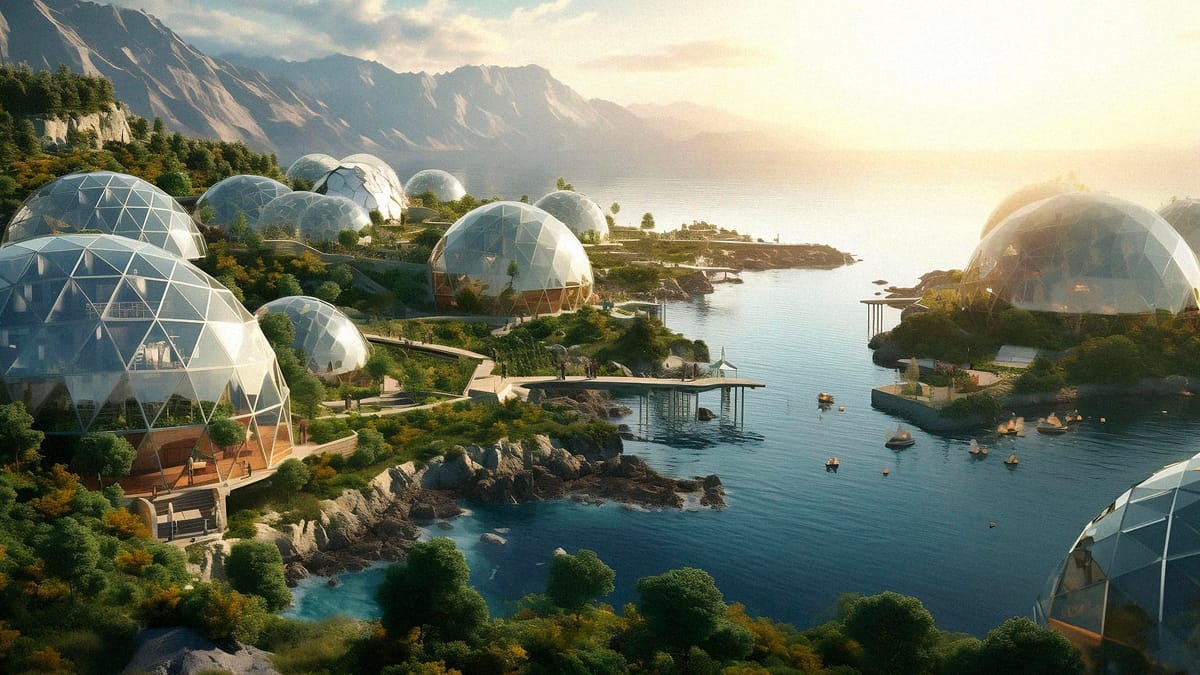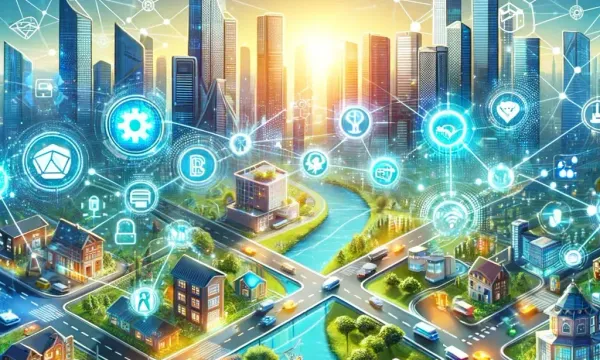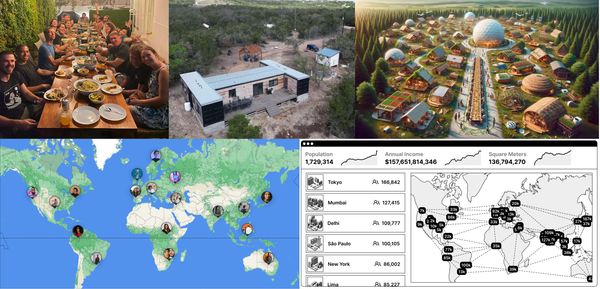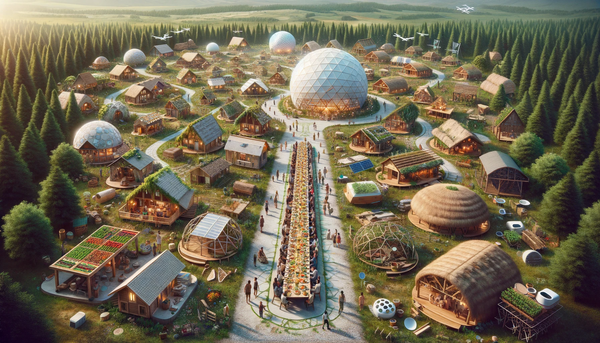Learning from popup villages

I have participated in 3 popup villages (Zuzalu, Vitalia, and Edge Esmeralda) and each one has given me increasing conviction in popup villages as an important form-factor for growing network societies. This essay includes some reflections on successful popup villages, why they work, and where they could go next.
The right scale and duration
A decade ago, Balaji shared this classification of cloud formations, which charts form factors for network societies by scale and duration. The dotted line indicates the frontier of "unobserved formations". I've added a red arrow to indicate where popup villages are pushing out the frontier:

On the top-right of the frontier, cohousing compounds like Radish are bringing together dozens of people for multiple years. On the bottom-left of the frontier, Burning Man has built the world's only popup city of tens of thousands that comes together for multiple weeks each year.
Now, with popup villages, we have seen hundreds of people from the internet gather for multiple months at a time. Not only does this put popup villages on the frontier of cloud formations, it puts them right in the middle of the chart. This seems to be a sweet spot for developing network societies. Popup villages are long enough to build relationships, but short enough to not require permanent relocation. They are big enough to be vibrant, but small enough to be feasible.
At this scale, busy people can commit to come for a few days: just long enough to give a talk, meet some new people, and contribute to the local culture. Nomads can join for months at a time and live in a constant co-created university. People can start to form an interwoven network of relationships that carries a culture forward across ephemeral events.
Ultimately, popup villages serve as a strong foundation for permanent ones. They create incredible ephemeral events—and a big opportunity for a demand-first approach to prototyping permanent places.
Learnings from effective popup villages
Zuzalu, which defined the model for a popup village, was spearheaded by Vitalik Buterin and happened in Montenegro in April/May of 2023. It brought together an incredibly high density of people from across crypto, AI, network societies, new cities, longevity, and other interesting areas of cutting edge tech. Personal highlights included singing karaoke with Vitalik, a Grimes deejayed dance party, and late night dinners with other network society builders.

While it was an unforgettable event, it was also an early prototype. The location (a remote resort in Montenegro) was too expensive, inconveniently located, not a good physical space for community building, and didn't result in longer-term plans for a more permanent hub. But the strength of the model and the people it attracted overcame these issues, and led to Vitalik sponsoring a grants program to spin off more instances of popup villages around the world.

Vitalia, a network city for longevity, received a grant from the Zuzalu spin-off program. They hosted a popup village in February 2024 in Honduras. Vitalia was different from Zuzalu in two key ways: they focused the event mostly on one topic (longevity), and they did it in a place where they intend to build a permanent home base (Prospera).
By focusing more narrowly, Vitalia was able to attract an aligned audience and go deeper on longevity: a biohacking lab, workout groups, healthy food, cold plunges, a biomedical hackathon, and relevant speakers like Bryan Johnson and Aubrey de Grey.

Even more importantly, Vitalia was hosted at Prospera, a special economic zone in Honduras that has the ability to offer biomedical treatments not approved by the FDA. This makes Prospera a great permanent home for Vitalia and the companies in its community that want to be able to work on longevity treatments. By seeding a focused community with recurring popups and the intention to build a more permanent location, Vitalia has developed a deeper sense of purpose and permanence than Zuzalu.
It is also a strong example of the symbiotic relationship between existing states and special economic zones that provide favorable regulatory anvd legal frameworks, and communities that want to build on top of these frameworks. You can think of it a bit like blockchains, which have L1s with base-level security guarantees and L2 communities built on top of them:

Most recently, I attended another Zuzualu spin-off called Edge Esmeralda, which is still happening as I write this in Healdsburg, CA (June 2024). EE is popup village designed to help seed a nearby permanent village called Esmeralda, the Chautauqua of the West. It has been my favorite popup village event so far for a few reasons: location, co-creation, and family-friendliness.

Healdsburg is a charming town of 11,000 people an hour north of San Francisco. While California is a bit more expensive and less globally accessible than other locations, it was also a short drive for the high density of strong builders in the Bay Area. The town itself was the right size to make most of the venues walkable/bikeable and had a great town square at the center for people to casually meet up. The organizers brought in a couple hundred Burning Man bikes, which helped make it easy to get around and added to the vibe.
Edge Esmeralda was spread across a dozen or so hotels, coworking spaces, and other venues to host events. The range of spaces made it easy to cowork during the day and participate in abundant programming on nights and weekends. Co-creation was highly encouraged, and they made it easy for anyone to add events to the shared calendar, which allowed people to host constant impromptu workshops, panels, and discussions:

While all of the popup village events I've attended have had elements of co-creation, it's great to see how much the technology behind these events has made this easier. Zuzalu was bootstrapped from scratch, and built infra like Zupass (their event ticketing system) onsite during the event. It was still a clunky early prototype—but now, a year later, it's a much more user friendly app. Similarly, Social Layer (which also came out of the Zuzalu ecosystem) made the shared calendar much more accessible and useable than past events, which led to more co-creation.
Edge Esmeralda was the first explicitly family-friendly popup village. It takes a village to raise kids, and popup villages are a natural fit for families. Every night at community dinner, there was a kids table full of markers, playdoh, and toys. Cabin hosted some gatherings for families in the park. There were activities and camps for kids of various ages. That said, there's lots of room for future popup villages to become even more family friendly, particularly with shared childcare.

How popup villages can grow into network cities
When I started writing about decentralized cities in 2021, I thought of them as networks of geographically dispersed permanent villages. It's now clear that in addition to being physically decentralized, they can also be ephemeral. Despite being in different times and places, all three of the popup villages I've discussed had strong overlap in terms of culture and participants. Participating in these popup villages is starting to feel like living in a network city.
Network societies start small and grow organically over time, because they are complex systems that follow Gall's law. In this essay, I explored a place-based way of doing this, by starting with dinner parties and growing local neighborhood infrastructure. While I still think that is a good approach, popup villages have demonstrated a compelling alternative path, which accelerates the scale of cloud formation (village) by changing the duration (ephemeral).
Some popup villages may choose to stay ephemeral forever; this is a reasonable path to avoid the problems of building long-term physical infra. It's the path Black Rock City has taken, and it has scaled remarkably well. But I worry that traveling ephemeral popups may lose some of their luster in the coming years, as people get their fill of the format and fickle nomads move on to the next hot thing.
For those that want to use the popup village model to create something more permanent, what's the playbook? I think it probably looks something like:
- Choose a home base
- Build permanent infra
- Make it family friendly
A crucial part of Vitalia and Edge Esmeralda are that they are popup events tied to a permanent place. Vitalia is building a permanent home at Prospera, and Esmeralda is building a permanent home near Healdsburg. In both cases, the popup village was a partnership between a team running the popup event (Vitalia, Edge City) and a group building the permanent city (Prospera, Esmeralda). This type of collaboration is fruitful, because the popup gets a sense of longer-term purpose and the city can grow a base of demand before investing in physical infra.
Once you have a physical place to call home, popup villages can start designing and building the long-term village. Vitalia hosted a conference to design their future village, and people prototyped solar A-frames at Edge Esmeralda. Some of Cabin's best gatherings have been our Build Weeks, where people come together to make progress on constructing a village. Another impressive popup village (which I didn't highlight in this essay because I haven't personally attended), is Mars College — which comes together for 3 months at a time to prototype an entire off-grid solarpunk residential community in the desert:

There's something magical about getting together with people and building the place you want to live. It is the practice of functional sovereignty—proof of work that your community can create the future it wants. Building together is an act of collective action and self-governance. It brings people together towards a clear common objective and creates a tangible, valuable outcome for the community. Whether you're creating a solarpunk college, a biohacking lab, or a community garden, what you build and how you build it is the real world manifestation of your community's values.
To the extent that popup villages want to become more permanent villages, I think the other crucial element will be making them intergenerational. It's easier to attract flexible 20-something nomads to a popup village than it is to attract kids and the elderly. But families tend to settle more permanently, and having an up-and-coming generation provides fundamental stability and longevity to a community.
It takes a village to raise kids, but it also takes kids to raise a village. That's why Cabin has oriented ourselves towards building a network city for families, and Esmeralda has intergenerational living as its first design principle. Cabin's Obvious Truth, Raise Kids Together, doesn't mean everyone has to have kids themselves—it means that everyone in the community gets to be a part of raising the village. That's ultimately how you grow a long-term culture.

How to get involved
If you read this and want to get involved in the popup village movement, here are some upcoming opportunities to join:
- Vitalia Summer Program, Prospera — July 1 - 31, 2024
- ZuVillage Georgia, Georgia — July 19 - August 31, 2024
- Edge City Lanna, Thailand — October 10th - November 10th, 2024
- Network Society Camp, Austin, TX — October 11 - 14th, 2024
Most popup events have limited capacity and choose attendees by application. To make your application stand out (and to have a good time at these events!) think about what you can contribute that will help grow the culture of the popup village.




